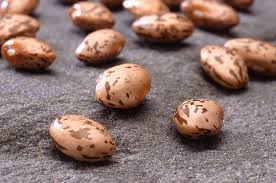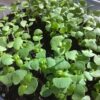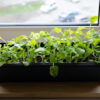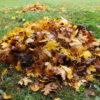Description
Pinto Bush Bean (a.k.a. Frijoles Pintos, Painted Beans)
50 Seeds per pack
Days to Maturity: 85–95 days
Sun Requirements: Full Sun
Botanical Name: Phaseolus vulgaris
Best Seller!
A staple of Southwestern and Mexican cuisine, the Pinto Bush Bean—also known as frijoles pintos or “painted beans”—is prized for its rich flavor, creamy texture, and exceptional versatility in the kitchen. This hardy, open-pollinated variety produces vigorous half-runner type plants reaching about 36″ tall. While trellising is optional, plants tend to yield more when given support. The pods, typically 4½–6½″ long, are borne close to the crown and contain 5–6 light buff-colored seeds speckled with warm brown markings.
Easy to grow and well-adapted to a range of climates, Pinto Bush Beans tolerate dry conditions and thrive in full sun. The mature dry beans store well—often keeping for up to five years under proper conditions—making them a favorite for long-term food storage.
Nutritious as well as delicious, pinto beans are naturally high in plant-based protein, fiber, calcium, phosphorus, potassium, iron, and B vitamins. Their hearty, satisfying flavor makes them a go-to choice for refried beans, chili, soups, stews, and bean dips. When fully cooked, they offer a smooth consistency and appealing aroma that enhances any dish.
A true staple, Pinto Bush Beans offer both culinary appeal and garden reliability in one dependable variety!
Planting Instructions for Pinto Bush Bean Seeds
When to Plant
Sow Pinto bean seeds outdoors once the danger of frost has passed and the soil has warmed to at least 60°F, ideally 70–80°F for best germination. This is typically 1–2 weeks after your average last frost date. Beans are frost-sensitive and should never be planted in cold, wet soil.
Where to Plant
Choose a site with full sun and well-drained soil. Avoid low or compacted areas where water tends to collect. A soil pH between 6.0 and 6.8 is ideal. Pinto beans prefer warm, sunny weather and will benefit from compost-enriched soil. If your soil is poor, amend it before planting.
How to Plant
Do not soak bean seeds before planting, as this can reduce germination rates. Sow seeds directly outdoors about 1″ deep in well-warmed soil. Space seeds 2–4″ apart in rows that are 18–24″ apart. If starting seeds indoors, plant them 1–1.5″ deep in pots and harden them off before transplanting. Use your finger or a dibber to make the holes, and cover the seeds lightly with soil.
Growing Notes
Pinto Bush Beans are a vigorous half-runner type, growing up to 36″ tall. Plants are productive and may benefit from support, though they will grow without it. Pods grow close to the crown and reach 4½–6½″ long, each typically containing 5–6 light buff-colored seeds with warm brown speckles. These beans are drought-tolerant and adapt well to a wide range of climates. Like other beans, they fix their own nitrogen and rarely need additional fertilizer. Keep soil moist but not soggy, especially during flowering and pod development. Mulch when plants are established to suppress weeds, retain moisture, and prevent soil splash.
Succession Planting
Pinto Bush Beans are typically grown for dry use and produce one main crop all at once. Staggered planting is generally not necessary unless growing for fresh eating early in the season. For dry beans, a single planting is sufficient.
Pests and Problems
Watch for Mexican bean beetles, stink bugs, leafminers, spider mites, and common fungal and bacterial diseases. Remove affected leaves promptly and practice 3-year crop rotation. Avoid handling wet foliage to reduce disease spread.
Harvesting
Harvest beans for dry use when pods are tan and brittle and beans inside rattle, typically around 85–95 days from planting.
- Option 1: Uproot the entire plant once 90% of the leaves have dropped. Hang to dry in a sheltered, well-ventilated area.
- Option 2: If conditions are humid, pick pods as they dry and finish drying them indoors.
Shell beans by hand, stomping dried pods in a sack, or dancing on them in a tub. Winnow with wind or a fan to separate beans from chaff. Beans must be hard and fully dry before storing.
Storage
Store fully dried beans in airtight glass jars or sealed containers in a cool, dark place. For long-term storage (5–10 years), use mylar bags or #10 cans with oxygen absorbers. Pinto beans store especially well and often keep excellent quality for up to five years. Beans should not be soft or dentable with a fingernail.
Cooking Tips
Pinto beans are ideal for chili, soups, stews, dips, and traditional refried beans. They have a rich flavor, smooth consistency, and excellent aroma when fully cooked. Like most dry beans, they benefit from overnight soaking followed by a 10-minute boil and a slow simmer until tender. Cooked beans freeze well with some cooking liquid in jars or containers.
Seed Saving
Save the best, fully mature pinto beans for next year’s planting. Choose pods that are dry, brittle, and tan in color. Shell the beans and check that they are hard and cannot be dented with a fingernail. Spread the seeds out on a screen or tray in a warm, dry, and well-ventilated space for an additional week or two to ensure they are completely dry. Once fully dry, store them in airtight containers such as seed saving envelopes or glass jars in a cool, dry, and dark place. Properly dried and stored seeds can remain viable for 3–5 years.
FAQ:
How long do Pinto Bush Beans take to mature?
Pinto Bush Beans typically reach maturity in 85–95 days when grown for dry use. Harvest when pods are dry, brittle, and the seeds rattle inside.
Do Pinto Bush Beans need a trellis or support?
While Pinto Bush Beans are a half-runner type and can grow without support, providing a low trellis or cage can increase airflow and improve yields.
Can Pinto Bush Beans tolerate drought?
Yes! Pinto Bush Beans are drought-tolerant once established, making them a reliable crop in dry conditions when grown in well-drained soil with full sun.
Can Pinto Bush Beans be substituted for other beans in recipes?
Yes, they can be used as a substitute for kidney beans or red beans in recipes, thanks to their versatile flavor and texture.
How do I know when Pinto Beans are ready to harvest?
Harvest when most of the leaves have dropped, and the pods have turned tan and brittle. Beans inside should be hard and rattle when shaken.
What do Pinto Bush Beans taste like?
They have a rich, creamy flavor and smooth texture when cooked—perfect for refried beans, chili, soups, stews, and dips.
How should I store dried Pinto Beans for food use?
Once fully dry, store pinto beans for eating in airtight containers such as glass jars, mylar bags, or #10 cans with oxygen absorbers. Keep them in a cool, dark place. Properly stored, they retain excellent quality for up to five years and are ideal for long-term food storage.
Can I save Pinto Bush Beans for planting next year?
Yes—just be sure to select fully mature, dry pods from healthy plants. After shelling, check that the seeds are hard and cannot be dented with a fingernail. Spread them to air-dry for 1–2 weeks before storing in paper envelopes or glass jars in a cool, dry place. Seeds will stay viable for 3–5 years if stored properly.
Do Pinto Bush Beans improve soil health?
Like other beans, Pinto Bush Beans are nitrogen-fixing, meaning they enrich the soil naturally and often require little to no fertilizer.
Can I grow Pinto Beans in containers?
Yes, as long as the container is at least 12–18″ deep with good drainage. Provide full sun and support if plants grow tall or begin to sprawl.
America will never be destroyed from the outside. If we falter and lose our freedoms, it will be because we destroyed ourselves. – Abraham Lincoln




















Dawn S. (verified owner) –
My grandparents always planted pinto beans instead of your basic green beans. Pinto beans make the best green beans. I’ve used store bought dried pintos and only had a good crop 10 years ago until last year when I ordered your pintos. We still have green beans in the freezer. Just planted some seeds yesterday and am hoping we have a good crop this year. I plant in elevated raised beds. NO MORE BENDING and pulling weeds.
Laura S. (verified owner) –
Came as expected
Scott S. (verified owner) –
Sweet seeds!
Kevin Pierson (verified owner) –
Good
Diana J. (verified owner) –
Happy
Sarah C. (verified owner) –
Price was just right and very well packaged!
Susan G. (verified owner) –
Seem to be doing fine.
Angela V. (verified owner) –